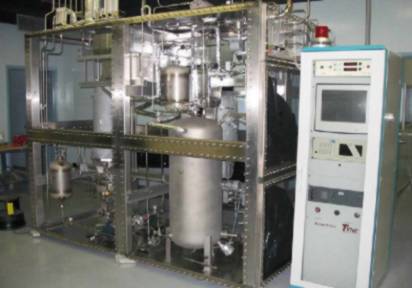Oxidizer- Tritium Removal from Organics
Model: 7030-OXZR-001
Application
May be used by Active Waste Facilities , Research Establishments, Nuclear Facilities and Fusion Laboratories. It is a process for converting organics containing tritium, to water that contains the tritium. It is easier to extract tritium for safe storage from water than from hydrocarbons, and so is the first step in a tritium removal process.
Features
-
Water containing tritium (plus any other impurities) can be drummed for later treatment by electrolysis and isotopic separation to remove and capture the tritium
-
Converts the carbon in tritium containing organic waste to carbon dioxide.
-
Oxidizes the tritium in organic waste to HTO
-
Only carbon dioxide and surplus oxygen is released to the atmosphere.

Description
This plant was designed and built by Tyne to take hydrocarbons containing tritium, and to separate out the carbon. This is done by first heating the hydrocarbons to high temperature over a catalyst with an abundance of oxygen to reduce the organics to carbon dioxide and water. The carbon dioxide together with excess oxygen will be filtered, dried, monitored for tritium and released to stack.
The water so formed will be filtered, purified and stored in readiness for further treatment in an electrolyzer so that it can be reduced to its hydrogen isotopes which can subsequently be separated to remove tritium.
The process is contained in a glove box to contain any permeated tritium. The drummed waste material is filtered to remove impurities and any solids, and is then injected into the oxidizer chamber. High temperatures are required for this operation together with excess oxygen. Tyne designed a hastelloy chamber for this purpose and designed an oxygen/ hydrocarbon injection nozzle to maximize surface area in the oxidization zone.
When the hydrocarbons have been completely oxidized, the heat is removed in a spray condenser, which will also contain all dissolved impurities and some insoluble components. These are collected and purified in preparation for either the long term storage of the water, or the electrolysis of the water in preparation for the full removal of tritium in a concentrator and isotopic separation system.


